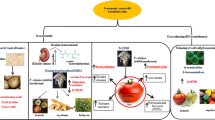Abstract
To produce stable mutants from Mankeumbyeo, a japonica rice (Oryza sativa L.) variety, we estimated the mutation efficiency of ethyl methane sulfonate (EMS) and N-methyl-N-nitrosourea (MNU) on fertilized egg cells using doubled haploids (DHs) derived from anther culture of M1 plants. M1 seed production and germination were higher in 1 mM MNU than in 94.2 mM EMS. A total of 68 DHs (35.4%) were regenerated by anther culture of M1 plants. Twenty-one DHs (30.9%) were stable mutants, 14 DHs (20.6%) were unstable mutants, and the remainder (48.5%) were normal. The frequencies of stable mutants following EMS and MNU treatments were 20.7% (three semidwarfs, one early maturation and one glabrous line) and 38.5% (three semidwarfs, two early maturation, four glabrous and one long grain line), respectively. In a field trial of seven stable mutants for yield potential, five mutants did not show a significant difference in yield as compared with the original variety. Among these five, three glabrous mutants (MK-MAC 1, MK-MAC 4 and MK-MAC 26) with a smooth leaf and hull may be considered to be improved mutant lines because of the health benefits (reduced skin damage and generation of less dust compared to the original variety) to farmers handling the plant materials. MK-MAC 26, a glabrous mutant, had also less shattering resistance than that of the original variety. These stable mutants could be used as new breeding materials.
Similar content being viewed by others
References
Aldemita RR, Zapata FJ (1991) Anther culture of rice, effects of radiation and media components on callus induction and plant regeneration. Cereal Res Commun 19:9–32
Asai T, Nakai H (1988) Induction of mutants of rice resistant to bacterial leaf blight through mutagenesis with chemicals. Bull Fac Agric Shizuoka Univ 38:53–59
Bansal VL, Katoch PC (1991) Selection of semidwarf, early maturing and blast resistant mutants after mutagenic seed treatment in two locally adapted Indian rice cultivars. Plant Breed 107:169–172
Chen QF, Wang CL, Lu YM, Shen M, Afza R, Duren MV, Brunner H (2001) Anther culture in connection with induced mutations for rice improvement. Euphytica 120:401–408
Chu CC, Wang CC, Sun C, Chon H, Yin KC, Chu CY, Bi FY (1975) Establishment of an efficient medium for anther culture of rice through comparative experiments on nitrogen sources. Sci Sin 18:659–668
Cornejo-Martin MJ, Primo-Millo E (1981) Anther and pollen grain culture of rice (Oryza sativa L.). Euphytica 30:541–546
Dat TV, Peterson ML, Rutger IN (1978) Performance of rice composites dimorphic for plant height and for pubescence. Crop Sci 18:1–4
Hu Z (1983) Stimulating pollen haploid culture mutation in Oryza sativa subsp. Keng (japonica). In: IRRI (ed) Cell and tissue culture techniques for cereal crop improvement. Science Press, Beijing/IRRI, Manila, pp 291–301
Jodon NE (1965) Four morphologic characters in rice. Inheritance and relation to yield and height of awned, glabrous, liguleless and long-glumed. Heredity 56:119–125
Kanra OP, Brunner H (1970) Chemical mutagens. Mode of action. In: FAO/IAEA (eds) Manual in mutation breeding. Tech Rep Ser 119:62–64. FAO/IAEA, Vienna
Kim HK (1977) The effect of gl, gh and wx gene on the grain yield and yield components of rice plant. Kor J Crop Sci 22:83–109
Kumar R, Mani SC, Kumar R (1997) Chemical mutagenesis in Manhar variety of rice (Oryza sativa L.). Indian J Genet 57:120–126
Laib Y, Szarejko I, Polok K, Maluszynski M (1996) Barley anther culture for doubled-haploid mutant production. Mutat Breed Newl 42:13–17
Lee JH, Lee SY (1995) Effects of gelling agents and growth regulators on rice anther culture. Kor J Plant Tissue Cult 22:35–39
Lee JH, Lee SY (2002) Selection of stable mutants from cultured rice anthers treated with ethyl methane sulfonic acid. Plant Cell Tissue Organ Cult 71:165–171
Lee SY, Lee JK, Noh TH, Kang HY, Lee SY (1993) Variation of major characters in plants regenerated from rice cells treated with ethyl methane sulfonic acid. Kor J Plant Tissue Cult 20:307-314
Ling DX, Luckett DJ, Darvey NL (1991) Low-dose gamma irradiation promotes wheat anther culture response. Aust J Bot 39:467–474
Maekawa M, Maekawa T, Hiwatari M, Tsunoda T, Kita F (1989) Comparison of mutagenic effectiveness by the treatment of fertilized egg cells with N-methyl-N-nitrosourea and ethylmethanesulfonate in rice (Oryza sativa L.). Bull Univ Farm, Hokkaido Univ 26:31–36
Mahendra S, Chaturvedi SN (1987) Effectiveness and efficiency of mutagens alone or in combination with dimethyl sulphoxide in Lathyrus sativus Linn. Indian J Agric Sci 7:503–507
Minocha JL, Gupta RK (1988) Induction of male sterility in rice using chemical mutagens. Mutat Breed Newl 32:5–6
Nishida K (1989) Breeding of rice for sake brewery. Jpn J Agric Tech 44:230–235
Phillips RL, Kaeppler SM, Olhoft P (1994) Genetic instability of plant tissue cultures: break down of normal controls. Proc Natl Acad Sci USA 91:5222-5226
Pillai MA, Subramanian M, Murugan S (1993) Effectiveness and efficiency of gamma rays and EMS for chlorophyll mutants in upland rice. Ann Agric Res 14:302–305
Sathish P, Gamborg OL, Nabors MW (1997) Establishment of stable NaCl-resistant rice plant lines from anther culture: distribution pattern of K+/Na+ in callus and plant cells. Theor Appl Genet 95:1203-1209
Satoh H, Omura T (1979) Induction of mutation by the treatment of fertilized egg cell with N-methyl-N-nitrosourea in rice. J Fac Agric Kyushu Univ 24:165–174
Swanson EB, Herrgesell MJ, Arnoldo M, Sippell DW, Wong RSC (1989) Microspore mutagenesis and selection: canola plants with field tolerance to the imidazolinones. Theor Appl Genet 78:525–530
Umba DU, Maluszynski M, Szarejko I, Zbieszczyk J (1991) High frequency of barley dihaploid-mutants from M1 after mutagenic treatment with MNH and sodium azide. Mutat Breed Newl 38:8–9
Acknowledgements
This work was supported by Wonkwang University in 2001.
Author information
Authors and Affiliations
Corresponding author
Additional information
Communicated by P.P. Kumar
Rights and permissions
About this article
Cite this article
Lee, S.Y., Cheong, J.I. & Kim, T.S. Production of doubled haploids through anther culture of M1 rice plants derived from mutagenized fertilized egg cells. Plant Cell Rep 22, 218–223 (2003). https://doi.org/10.1007/s00299-003-0663-0
Received:
Revised:
Accepted:
Published:
Issue Date:
DOI: https://doi.org/10.1007/s00299-003-0663-0




